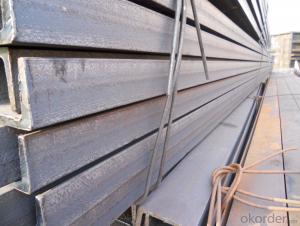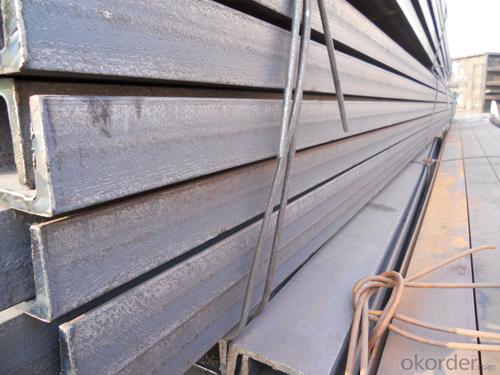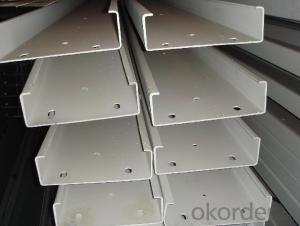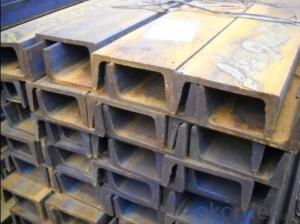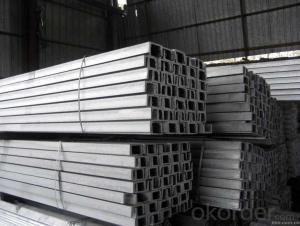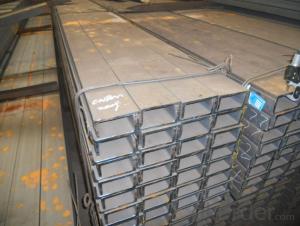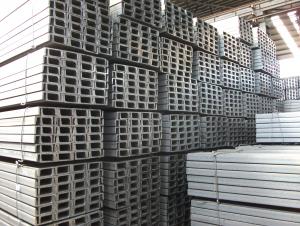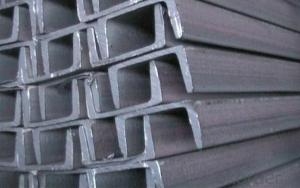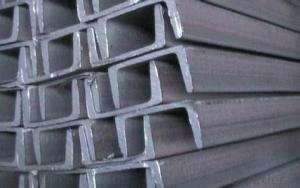Hot Rolld Steel U-channel with Many Standards Q235
- Loading Port:
- China Main Port
- Payment Terms:
- TT or LC
- Min Order Qty:
- -
- Supply Capability:
- -
OKorder Service Pledge
OKorder Financial Service
You Might Also Like
Product Description:
OKorder is offering STEEL CHANNEL at great prices with worldwide shipping. Our supplier is a world-class manufacturer of steel, with our products utilized the world over. OKorder annually supplies products to European, North American and Asian markets. We provide quotations within 24 hours of receiving an inquiry and guarantee competitive prices.
Product Applications:
The steel u channel can be applied to construction of warehouses, workshops, sport stadiums and car parks etc. In details, the steel u channel belongs to carbon structural steel which is applied to in the field of construction and machinery. The steel u channel is usually used for arch-itechtural structure, and they could be welded in order to support or hang a vari-ety of facilities. They are also usually used in combination with I beam. Generally,the steel u channel must possess perfect welding property, riveting property and mechanical property and so on.
Product Advantages:
OKorder's STEEL CHANNELare durable, strong, and resist corrosion.
Main Product Features:
· Premium quality
· Prompt delivery & seaworthy packing (30 days after receiving deposit)
· Corrosion resistance
· Can be recycled and reused
· Mill test certification
· Professional Service
· Competitive pricing
Product Specifications:
Minimum Order Quantity: 25 Tons Unit: m.t. Loading Port: Xingang Port
Supply Ability: 1000 Tons Per Day Payment Terms: TT or L/C
Product Description:
Specifications of Steel U Channel:
Standard Applied: GB Standard, EN Standard(UPN), JIS Standard
Sizes: 50mm to 300mm
Material Grade: Q235B, Q345B, S235JR, SS400, ASTM A36
Usage/Application of Steel U Channel:
The steel u channel can be applied to construction of warehouses, workshops, sport stadiums and car parks etc. In details, the steel u channel belongs to carbon structural steel which is applied to in the field of construction and machinery. The steel u channel is usually used for arch-itechtural structure, and they could be welded in order to support or hang a vari-ety of facilities. They are also usually used in combination with I beam. Generally,the steel u channel must possess perfect welding property, riveting property and mechanical property and so on.
Package & Delivery: Steel U Channel
The steel u channel will be packed in bundle with steel wire at each end of every bundle and color marking in order to help the customer to recognize his goods more easily at sight.
And steel u channel could be loaded into 20ft or 40ft container, or by bulk cargo. If the weight of each bundle reaches less than 3.5 mt, the loading by break bulk cargo should be choosed. When the weight of each bundle reaches less than 3mt, the loading by container should be choosed.
As for the transportaion from mill to loading port, the truck will be usually used. And the maximum quantity for each truck is 40mt.
All in all, we could do in accordance with customer's request
Alloy No | Grade | Yielding Strength Point(Mpa) | |||
Thickness(mm) | |||||
≦16 | >16-40 | >40-60 | >60-100 | ||
≧ | |||||
Q235 | B | 235 | 225 | 215 | 205 |
Alloy No | Grade | Tensile Strength(Mpa) | Elongation After Fracture(%) | |||
Thickness(mm) | ||||||
≦16 | >16-40 | >40-60 | >60-100 | |||
≧ | ||||||
G235 | B | 375-500 | 26 | 25 | 24 | 23 |
FAQ:
Q1: Why buy Materials & Equipment from OKorder.com?
A1: All products offered byOKorder.com are carefully selected from China's most reliable manufacturing enterprises. Through its ISO certifications, OKorder.com adheres to the highest standards and a commitment to supply chain safety and customer satisfaction.
Q2: How do we guarantee the quality of our products?
A2: We have established an advanced quality management system which conducts strict quality tests at every step, from raw materials to the final product. At the same time, we provide extensive follow-up service assurances as required.
Q3: How soon can we receive the product after purchase?
A3: Within three days of placing an order, we will begin production. The specific shipping date is dependent upon international and government factors, but is typically 7 to 10 workdays.
Q4: What makes stainless steel stainless?
A4: Stainless steel must contain at least 10.5 % chromium. It is this element that reacts with the oxygen in the air to form a complex chrome-oxide surface layer that is invisible but strong enough to prevent further oxygen from "staining" (rusting) the surface. Higher levels of chromium and the addition of other alloying elements such as nickel and molybdenum enhance this surface layer and improve the corrosion resistance of the stainless material.
Images:
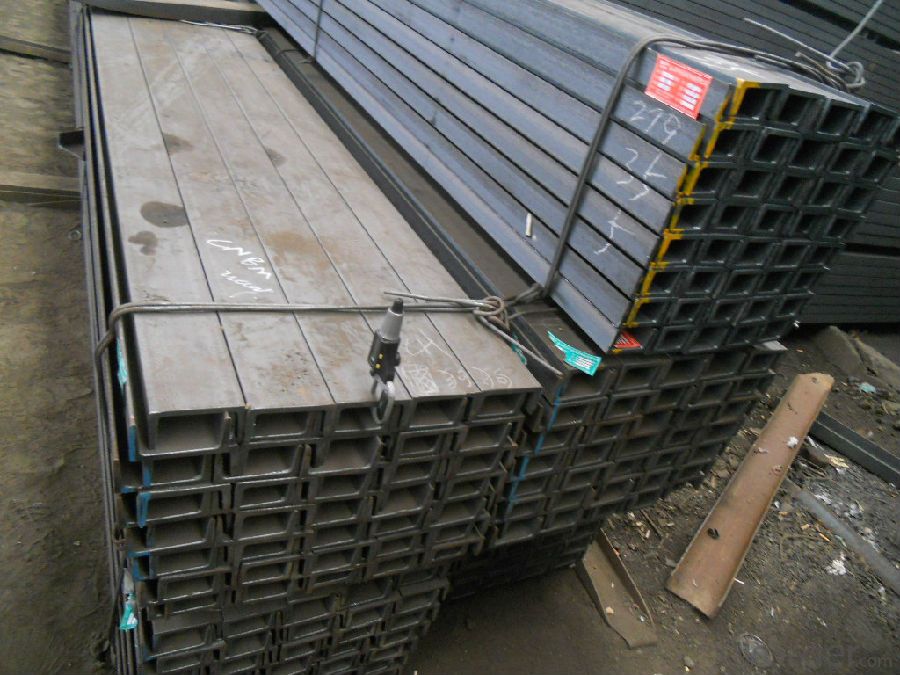
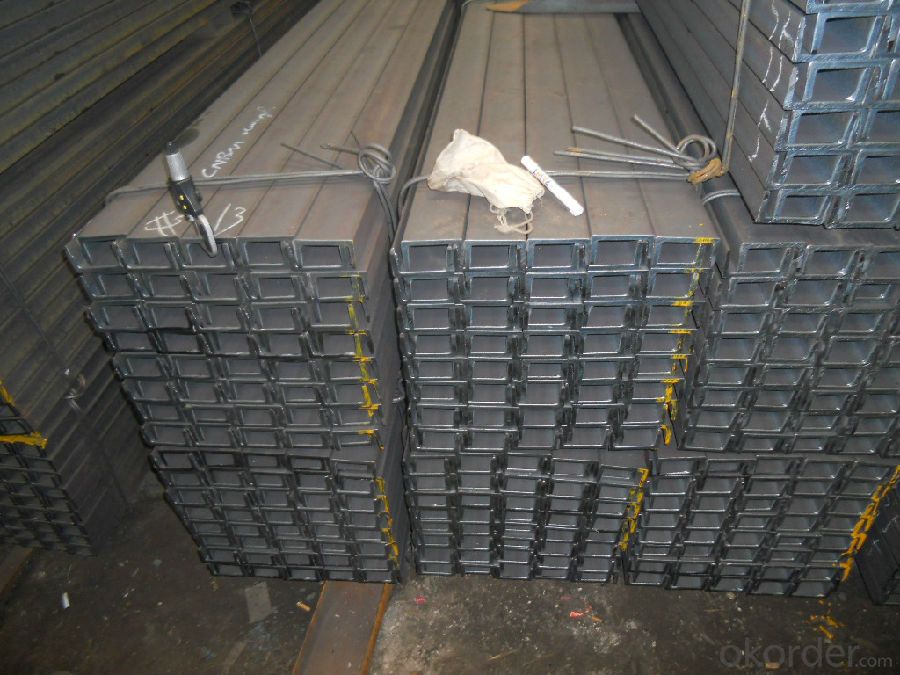
- Q: How do steel channels compare to timber or concrete channels?
- Steel channels have several advantages over timber or concrete channels. Firstly, steel channels are stronger and more durable than timber channels. They have a higher load-bearing capacity and can withstand heavy loads without warping or bending. This makes steel channels ideal for applications where strength and durability are crucial, such as in construction projects or industrial settings. Secondly, steel channels are more resistant to environmental factors such as moisture, rot, and pests, which can significantly affect timber channels. Steel channels do not require regular maintenance, unlike timber channels, which may need to be treated or replaced over time. Additionally, steel channels offer greater design flexibility compared to timber or concrete channels. Steel channels can be easily fabricated and customized to fit specific dimensions and requirements. This makes them suitable for a wide range of construction and engineering projects. Furthermore, steel channels have a longer lifespan compared to timber or concrete channels. They are not prone to decay or degradation, ensuring that they will last for many years without the need for replacement. This can result in cost savings in the long run, as there is no need for frequent repairs or replacements. Overall, steel channels provide superior strength, durability, resistance to environmental factors, and design flexibility compared to timber or concrete channels. They are a reliable and efficient choice for various construction and engineering applications.
- Q: Can steel channels be used in agricultural buildings?
- Yes, steel channels can be used in agricultural buildings. They provide structural support and durability, making them suitable for various applications such as framing, support beams, and roof trusses in agricultural structures.
- Q: Can steel channels support electrical wiring?
- Yes, steel channels can support electrical wiring. Steel channels are commonly used in electrical installations to provide structural support and protection for electrical wiring. They are durable, strong, and can be easily mounted on walls or ceilings to hold and conceal electrical cables.
- Q: How do steel channels perform in high-temperature applications?
- Steel channels perform well in high-temperature applications due to their inherent strength and heat-resistant properties. Steel is known for its durability and ability to withstand extreme temperatures without compromising its structural integrity. In high-temperature environments, steel channels maintain their shape and stability, ensuring the safety and reliability of the structure they support. Additionally, steel channels have excellent thermal conductivity, which allows for efficient heat transfer and dissipation, preventing excessive heat buildup. This makes them suitable for various high-temperature applications such as industrial furnaces, boilers, and heat exchangers. Moreover, steel channels can be fabricated and treated to enhance their resistance to oxidation and corrosion, further improving their performance in high-temperature environments. Overall, steel channels are a reliable and efficient choice for high-temperature applications due to their strength, heat resistance, and thermal conductivity.
- Q: Are steel channels suitable for mining and industrial applications?
- Steel channels are an excellent choice for mining and industrial applications. These structural elements are made of steel and possess exceptional strength and durability. This makes them perfect for heavy-duty tasks. In mining, steel channels are commonly used to construct support structures like roof supports, beams, and columns. They provide the necessary strength to withstand the extreme conditions, loads, and vibrations associated with mining operations. In industrial applications, steel channels are widely used for various purposes. They serve as support structures for heavy machinery and equipment, providing stability and rigidity. Steel channels also function as frames for conveyor systems, platforms, and walkways, ensuring safe and efficient movement within industrial facilities. Their versatility allows for customization and adaptation to specific requirements, making them an excellent choice for different industrial applications. Moreover, steel channels offer several advantages that make them suitable for mining and industrial applications. Firstly, steel is highly resistant to corrosion, which is crucial in environments where exposure to moisture, chemicals, and other harsh elements is common. This resistance ensures the longevity and reliability of the steel channels, reducing maintenance costs. Secondly, steel channels have excellent load-bearing capacity, allowing them to bear heavy loads and withstand significant forces. This is essential in mining and industrial settings, where heavy machinery, equipment, and materials are often involved. Lastly, steel channels are easy to fabricate and install, providing flexibility in design and construction. They come in various sizes, shapes, and lengths, allowing for customization to specific project requirements. Their easy installation also minimizes downtime during construction, ensuring efficient operations in mining and industrial applications. In conclusion, steel channels are highly suitable for mining and industrial applications due to their strength, durability, corrosion resistance, load-bearing capacity, and ease of fabrication and installation. They provide the necessary support and stability required in these demanding environments, making them a reliable choice for such applications.
- Q: What calculates the endurance of a channel?
- You see the position of the connection, the size of the material and some other factor, such as: channel three directions can be put, namely: upright, upward, lying and N, which support: two ends simply supported and fixed at both ends, and the other end of the cantilever end of the cantilever, the cantilever simply supported at both ends.......
- Q: How do steel channels contribute to the overall aesthetics of a structure?
- Steel channels can contribute to the overall aesthetics of a structure in several ways. Firstly, steel channels offer a sleek and modern appearance with their clean, straight lines. This can create a visually appealing and contemporary look that is often desired in modern architectural designs. Additionally, steel channels can be used creatively to enhance the architectural features of a building. They can be incorporated into the design to create interesting patterns, shapes, or even unique structural elements. By strategically placing steel channels, architects and designers can add visual interest and depth to the structure, making it more visually appealing. Moreover, steel channels are available in various sizes, thicknesses, and finishes, allowing for customization and versatility in design. Whether it is a large-scale commercial building or a residential structure, steel channels can be tailored to meet specific aesthetic requirements. They can be painted, coated, or left exposed, providing options for different design styles and preferences. Furthermore, steel channels offer durability and longevity, which can contribute to the overall aesthetics of a structure. With their robust construction, steel channels can withstand harsh weather conditions, resist corrosion, and require minimal maintenance. This ensures that the structure maintains its aesthetic appeal for an extended period, without the need for frequent repairs or replacements. In summary, steel channels contribute to the overall aesthetics of a structure by providing a sleek and modern appearance, allowing for creative design possibilities, offering customization options, and ensuring durability and longevity. Whether it is through their clean lines, unique patterns, or versatile finishes, steel channels can enhance the visual appeal of a building, making it visually pleasing and architecturally striking.
- Q: How do steel channels contribute to the overall cost-effectiveness of a project?
- Steel channels contribute to the overall cost-effectiveness of a project in several ways. Firstly, they are lightweight yet strong, allowing for efficient transportation and installation, reducing labor and transportation costs. Secondly, their durability and resistance to corrosion minimize maintenance and replacement expenses over time. Additionally, steel channels are readily available and can be easily fabricated to specific project requirements, eliminating the need for custom-made components and reducing material costs. Overall, the use of steel channels helps optimize project budgets while ensuring long-term structural integrity.
- Q: What are the different corrosion protection methods for steel channels?
- There are several different corrosion protection methods for steel channels that can be employed to enhance their durability and prevent corrosion. These methods can be broadly categorized into surface treatments, coatings, and cathodic protection. Surface treatments involve various techniques to modify the surface of the steel channel, making it more resistant to corrosion. One common method is mechanical cleaning, which involves removing any dirt, rust, or mill scale from the surface using abrasive techniques such as sandblasting or wire brushing. Chemical treatments like acid pickling can also be used to remove impurities and create a clean surface. Coatings are another effective corrosion protection method for steel channels. These coatings act as a barrier between the steel surface and the environment, preventing corrosive substances from coming into contact with the steel. Some common coating options include paint, epoxy, zinc, or galvanization. Paints and epoxy coatings provide a protective layer, while zinc or galvanization create a sacrificial layer that corrodes instead of the steel channel. Cathodic protection is a technique used to protect steel channels by making them the cathode of an electrochemical cell. This method involves the installation of sacrificial anodes or impressed current systems. Sacrificial anodes, typically made of metals like zinc or magnesium, are connected to the steel channel. These anodes corrode instead of the steel, effectively protecting it from corrosion. Impressed current systems, on the other hand, use an external power source to direct a small current onto the steel channel, preventing corrosion. It is important to note that the choice of corrosion protection method depends on various factors such as the environment, application, and budget. Consulting with corrosion experts or engineers can help determine the most suitable protection method for specific steel channel requirements.
- Q: Can steel channels be customized according to specific requirements?
- Yes, steel channels can be customized according to specific requirements. Steel channels are commonly used in construction and manufacturing industries for various purposes such as framing, support, and reinforcement. They can be customized in terms of size, shape, length, thickness, and material composition to meet specific project requirements. Customization of steel channels allows for greater flexibility and adaptability in various applications. For instance, the size and shape of the channel can be altered to fit specific structural designs or to accommodate specific loads and stresses. The length of the channel can be customized to suit the dimensions of the project, while the thickness can be modified to provide the desired strength and durability. Furthermore, steel channels can be customized in terms of material composition. Different types of steel, such as carbon steel, stainless steel, or alloy steel, can be utilized based on the specific requirements of the project. This customization ensures that the steel channel possesses the necessary properties, such as corrosion resistance, heat resistance, or high tensile strength, to withstand the intended application. Overall, steel channels can indeed be customized according to specific requirements, offering a versatile solution for various construction and manufacturing needs.
Send your message to us
Hot Rolld Steel U-channel with Many Standards Q235
- Loading Port:
- China Main Port
- Payment Terms:
- TT or LC
- Min Order Qty:
- -
- Supply Capability:
- -
OKorder Service Pledge
OKorder Financial Service
Similar products
Hot products
Hot Searches
Related keywords
